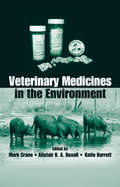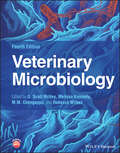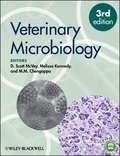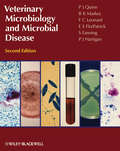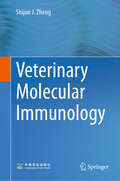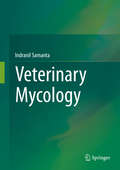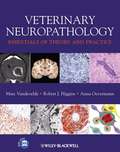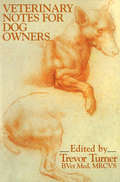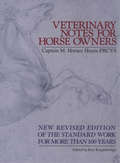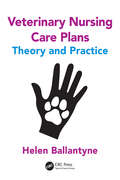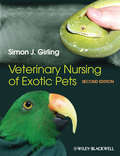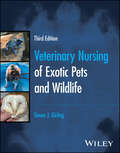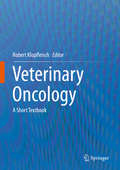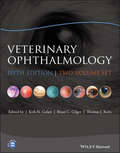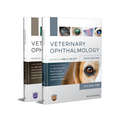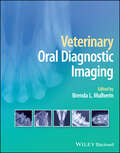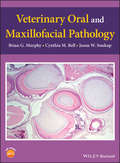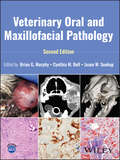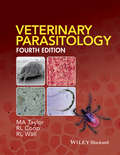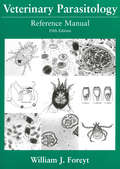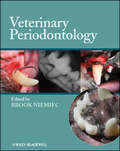- Table View
- List View
Veterinary Medicines in the Environment
by Mark Crane Alistair B. A. Boxall Katie BarrettExamine the Current State of the ScienceSurface water sampling programs across the globe have shown the presence of many different classes of medicines. The potential risks associated with the release of these medicines into the environment have become an increasingly important issue for environmental regulators. Effects of Veterinary Medicines in
Veterinary Microbiology
by Melissa Kennedy M. M. Chengappa D. Scott McVey Rebecca WilkesVeterinary Microbiology Comprehensive reference work on the bacterial, fungal, and viral pathogens that cause animal diseases Veterinary Microbiology, Fourth Edition presents comprehensive information based on the most recent research, diagnostic, and clinical publications for bacterial, fungal, and viral animal diseases. The information provided is intended to be most relevant for veterinary students and practitioners. The text is supported throughout by high-quality and full-color images to aid learning. A companion website offers chapter content, supplemental information, and figures from the book in PowerPoint format. Sample topics discussed within the book include: Pathogenic bacteriology: includes major classifications and genera of bacteria associated with veterinary infectious disease Pathogenic mycology: dermatophytes, agents of subcutaneous mycoses, and agents of systemic mycoses Pathogenic virology: includes RNA and DNA viruses as well as prions associated with veterinary infectious disease
Veterinary Microbiology
by Melissa Kennedy M. M. Chengappa D. Scott McveyVeterinary Microbiology, Third Edition is a comprehensive reference on the bacterial, fungal, and viral pathogenic agents that cause animal disease. Now in full color with improved images throughout, the new edition has been thoroughly updated to reflect information from current research and diagnostic and clinical publications. Key changes include a review of microbial cell structure and function and increased emphasis on the key points of pathogenesis and host responses to infection.Organized into four sections, the Third Edition begins with an updated and expanded introductory section on infectious disease pathogenesis, diagnosis and clinical management. The second section covers bacterial and fungal pathogens, and the third section describes viral diseases and viruses. The final section presents a systematic approach of describing infection and disease of animals. Equally useful for beginning veterinary students and seasoned practitioners, Veterinary Microbiology offers a thorough introduction and reference text for veterinary infectious disease.
Veterinary Microbiology and Microbial Disease
by P. J. Quinn S. Fanning F. C. Leonard P. Hartigan B. K. Markey E. S. FitzpatrickMicrobiology is one of the core subjects for veterinary students, and since its first publication in 2002, Veterinary Microbiology and Microbial Disease has become an essential text for students of veterinary medicine. Fully revised and expanded, this new edition updates the subject for pre-clinical and clinical veterinary students in a comprehensive manner. Individual sections deal with bacteriology, mycology and virology. Written by an academic team with many years of teaching experience, the book provides concise descriptions of groups of microorganisms and the diseases which they cause. Microbial pathogens are discussed in separate chapters which provide information on the more important features of each microorganism and its role in the pathogenesis of diseases of animals. The international and public health significance of these pathogens are reviewed comprehensively. The final section is concerned with the host and is organized according to the body system affected.Tables, boxes and flow diagrams provide information in an easily assimilated format. This edition contains new chapters on molecular diagnostics and on infectious conditions of the skin, cardiovascular system, urinary tract and musculoskeletal system. Many new colour diagrams are incorporated into this edition and each chapter has been updated.Key features of this edition:Twelve new chapters includedNumerous new illustrationsEach chapter has been updatedCompletely re-designed in full colourFulfils the needs of veterinary students and academics in veterinary microbiologyCompanion website with figures from the book as Powerpoints for viewing or downloading by chapter: www.wiley.com/go/quinn/veterinarymicrobiologyVeterinary Microbiology and Microbial Disease remains indispensable for all those studying and teaching this essential component of the veterinary curriculum.
Veterinary Molecular Immunology
by Shijun J. ZhengThis book focuses primarily on the newly discovered theory and techniques of veterinary molecular immunology. It also covers application of modern immunological methods into the treatment and control of infectious diseases and cancer, and future research trends. In terms of new immunological theories, this book focuses on recently-discovered innate lymphocytes (ILCs), signal transduction triggered by engagement of pattern recognition receptors (PRRs) with pathogen-associated molecular patterns (PAMPs), and signal communication between nerve and immune systems, antimicrobial peptides, immunoregulation and checkpoint, development and maturation of T and B lymphocytes, regulatory T cells, immune tolerance, and immunosuppression and evasion. In terms of new techniques and application, the book covers the categories and designs of preventive and therapeutic vaccines and the principle of developing vaccination program, occurrence, development and immune evasion of cancer cells, and the novel techniques for cancer therapy. In addition, comparison of avian and porcine cytokines with human and mouse ones is also provided in the appendices to illustrate the differences in cytokines between species. This book is valuable for the undergraduates, graduate students or professional researchers with requirement for advanced studies in veterinary immunology. It meets their requirements for improving and expanding knowledge of immunology.
Veterinary Mycology
by Indranil SamantaThis book is a comprehensive overview of the fungi that are clinically relevant for animals and humans. It is divided in three major parts: the first part comprises the history of veterinary and medical mycology, general aspects of morphology, growth, nutrition, reproduction and classification of fungi. In the second part, the etiologic agents of cutaneous, subcutaneous and systemic mycoses are described in detail with special emphasis on emerging and uncommon pathogenic fungi. Each chapter consists of a brief history and the morphology, classification, reproduction, susceptibility to disinfectants, natural habitat, distribution, genome, isolation, growth and colony characteristics, antigenic characteristics, virulence factors. The major diseases and their routes of transmission, pathogenesis, immunity, diagnosis and treatment are also covered. The third part focuses on laboratory diagnosis including clinical sample collection, their processing for fungal isolation, special stains for microscopic visualization, culture media composition and a relevant glossary. Each chapter includes color photographs, schematic diagrams and tables for better understanding.
Veterinary Neuropathology
by Marc Vandevelde Anna Oevermann Robert HigginsIntroducing the theoretical and practical basics of veterinary neuropathology, this concise and well illustrated book is an essential basic diagnostic guide for pathologists, neurologists and diagnostic imaging specialists. It presents readers with strategies to deal with neuropathological problems, showing how to interpret gross and histological lesions using a systematic approach based on pattern recognition. It starts with an overview of the general principles of neuroanatomy, neuropathological techniques, basic tissue reaction patterns, and recognition of major lesion patterns. The book goes on to cover vascular diseases, inflammatory diseases, trauma, congenital malformations, metabolic-toxic diseases, neoplasia and degenerative diseases mainly of the central nervous system. In the respective chapters pathologists can quickly find information to support their daily diagnostic workup for both small and large domestic species. Based on the authors' extensive diagnostic and post graduate teaching experience as well as the inclusion of MRI as it relates to neuropathology, this book also offers a comprehensive but basic analysis of veterinary neuropathology that neurologists and other MRI users will find very useful. * An essential manual for daily diagnostic work * Richly illustrated with high quality colour gross, histological and MRI images * Includes a section on the function and use of MRI (by Johann Lang, DECVDI) * Accompanied by a website presenting MRI sequences for interpretation and correlation with neuropathological findings edited by Johann Lang (University of Bern, Switzerland) and Eric Wiesner (University of California, Davis, USA)
Veterinary Notes For Cat Owners
by Trevor Turner Jean TurnerA comprehensive and accessible manual of feline medicine and surgery, it explains the symptoms and treatment of every disease or injury that a cat owner is likely to encounter. Written in a straightforward manner by experts in their fields, the book contains detailed sections on anatomy and physiology; the organ systems (digestive, cardiovascular reproductive, urinary, nervous, endocrine, locomotor, ear/eye/nose, immune, blood and skin); infectious diseases (bacterial, viral, parasitic etc); and poisoning. Including chapters on nursing, first aid medicines, dentistry, nutrition and feeding as well as advice for new owners and sections on showing, breeding, insurance and behaviour. This book will become the standard work on feline health care.
Veterinary Notes For Dog Owners
by Trevor TurnerDogs are now arguably the most popular companion animals, and the general wellbeing of the family pet is of paramount importance to many people. Today far more veterinary surgeons are concerned with the welfare of dogs than with any other animal.Veterinary Notes for Dog Owners provides a detailed, authoritative and easily understood text for the professional breeder and pet owner alike, as well as for veterinary surgeons and nurses looking for clear, up-to-the minute explanations of sometimes complex issues. Twenty authors, all experts in their particular fields, have come together under the astute editorial guidance of leading veterinary surgeon Trevor Turner BVetMed, MRCVS, to cover all aspects of canine health care and management. There are detailed sections on general and inherited disease, the organ systems and infectious and parasitic diseases; on nutrition and feeding; on first aid, poisoning, and nursing the sick dog; canine dentistry and hernias; on behavior and behavioral problems. Invaluable advice on choosing a dog and building kennels is included as well as such topics as understanding pet insurance. This book is destined to become the standard work on canine health care and management, the essential manual for anybody who takes a serious interest in the welfare of dogs.
Veterinary Notes For Horse Owners
by M. Horace HayesFor nearly 125 years, Captain Hayes' Veterinary Notes for Horse Owners has been the standard work on equine health care, constantly amended and updated. Leading veterinary specialists from Britain and around the world have been recruited to write this edition, the 18th, so it will continue to provide a totally comprehensive guide to horse medicine and surgery, explaining the symptoms and treatment of every disease or injury that the horse owner is likely to encounter. Written in plain language that both experts and novices will appreciate, the book contains detailed sections on the Organ, Musculoskeletal and Reproductive Systems, Infectious Diseases, Medical and Surgical matters, Management and Husbandry, and a variety of other important issues. New for this edition are section on Performance Analysis and Artificial Insemination. Clear, concise and authoritative, Veterinary Notes for Horse Owners saves horses lives.
Veterinary Nursing Care Plans: Theory and Practice
by Helen BallantyneKey features The first veterinary textbook dedicated to nursing care plans Covers the theory and practice of nursing care planning, examining and critiquing the topic in depth Provides basic definitions and explanations for those unfamiliar with nursing care plans Draws comparisons and contrasts between the veterinary and human nursing roles and contexts This book offers a broad overview of the theory and practice of care planning in veterinary nursing, answering three key questions: What are nursing care plans? Why should nursing care plans be used in practice? How should nursing care plans be used in practice? It provides basic definitions and explanations which will be useful to those unfamiliar with nursing care plans. For those veterinary nurses and technicians who are using nursing care plans, the content stimulates debate and discussion, by covering some of the philosophical and theoretical aspects of nursing and drawing comparisons and contrasts between the veterinary and human nursing roles and contexts. There is a pressing need for veterinary nurses to establish themselves as professionals and develop their unique role within the veterinary care team. Nursing care plans are a core tool to support that development. It is hoped that veterinary nurses may borrow tools from the pages of this book or use it as a resource design their unique care plans: either way, this practical guide will support the application of care planning, no matter the species of the animal kingdom for whom you are caring.
Veterinary Nursing of Exotic Pets
by Simon J. GirlingVeterinary Nursing of Exotic Pets is the definitive reference book on the principles and practice of nursing exotic species. From rabbits and chinchillas to budgies and iguanas, it not only covers husbandry, nutrition and handling, but provides an overview of diseases and treatments, and explores anatomy and chemical restraint. The redesigned layout and full colour artwork make it quicker and easier to find exactly what you're looking for.New coverage for this revised and enlarged second edition includes: emergency and critical care, radiography, and small marsupials such as sugargliders. In addition to the thorough explanations of appropriate home-care which will enable you to confidently advise clients, the book now also covers the care of hospitalised exotics.Key features:Provides an understanding of the basics of diseases, husbandry, anatomy and physiology of exotic pets as outlined by the RCVS examinationsGives veterinary nurses the confidence to discuss exotic pets with clients by providing a solid knowledge base in these species.This book acts as a companion to the City and Guilds NVQ level 4 equivalent qualification 'Veterinary Nursing of Exotic Species'.Suitable for veterinary nurses, veterinary technicians and veterinary students.
Veterinary Nursing of Exotic Pets and Wildlife
by Simon J. GirlingLearn the principles and practice of veterinary nursing for exotic pets and wildlife The third edition of Veterinary Nursing of Exotic Pets and Wildlife is a revised and expanded update of the essential text for veterinary nurses caring for exotic pets and wildlife species. Organised into logical sections, the text covers the anatomy and physiology, housing, husbandry, handling, nutrition, diseases, therapeutics, diagnostic imaging, and critical care medicine of a wide variety of exotic species, as well as a an entirely new section on wildlife treatment and rehabilitation. From small mammals like rabbits and mice to avian species, reptiles, amphibians, and Eurasian wildlife species, the author includes everything you need to succeed as a veterinary nurse studying for the RCVS nursing syllabus, as well as postgraduate and advanced programs in Veterinary Nursing of Zoo, Exotics, and Wildlife species. Readers will find: Information on common exotic pet species, such as rabbits, rodents, African pygmy hedgehogs, lizards, snakes, tortoises and cage birds An entirely new section on wildlife species, including chemical restraints, therapeutics, and rehabilitation A focus on evidence-based care practice and the latest guidance for veterinary nursing Appendices, including nursing care plans for exotic pets and wildlife with filled out example cases Veterinary Nursing of Exotic Pets and Wildlife is essential reading for both students and practitioners, and the new edition remains the gold standard in the field of veterinary nursing.
Veterinary Office Practices Second Edition
by Vicki JudahThe book provides an inside look at the exciting roles and responsibilities of veterinary assistants in animal hospitals or private veterinary practice, along with detailed instructions on everything you need to work successfully within a veterinary practice.
Veterinary Oncology
by Robert KlopfleischThis highly readable textbook provides a comprehensive but concise overview of the principles of oncogenesis in veterinary medicine, discussing selected tumors in domestic animals in detail, and addressing cancer diagnostics and therapy. All chapters are illustrated with histological and radiological images to enhance readers' understanding. Accordingly, the book is a must-have reference guide for all graduate and advanced undergraduate students in Veterinary Medicine with a special interest in oncology.
Veterinary Ophthalmology
by Thomas J. Kern Kirk N. Gelatt Brian C. GilgerVeterinary Ophthalmology, Fifth Edition is a fully updated version of the gold-standard reference for diseases and treatment of the animal eye in veterinary medicine. With an internationally renowned list of contributing authors, the book has been revised and expanded to incorporate the most up-to-date research and information. New chapters cover ophthalmic genetics and DNA tests, microsurgery, photography, camelid ophthalmology, and rabbit ophthalmology, and existing chapters feature expanded coverage of noninvasive imaging techniques, feline ophthalmology, equine ophthalmology, and marine mammals and penguins.The book retains its classic structure, with sections on basic vision sciences, the foundations of clinical ophthalmology, canine ophthalmology, and special ophthalmology, which encompasses specific coverage of most commonly treated species and chapters on neuro-ophthalmology and systemic diseases. A companion website offers the images from the book available for download in PowerPoint and the references linked to CrossRef. Veterinary Ophthalmology remains the most comprehensive resource for authoritative information on veterinary ophthalmology worldwide and is a key reference for anyone interested in veterinary or comparative ophthalmology.
Veterinary Ophthalmology: Two Volume Set
by Thomas J. Kern Brian C. Gilger Caryn E. Plummer Gil Ben-Shlomo Diane V. HendrixOffering the very latest in diagnostics and therapeutics, this book presents a fully updated and revised edition of the definitive reference to veterinary ophthalmology. Covering both basic sciences and clinical treatment, it is a state-of-the-art text that encompasses ophthalmology in all species, including dogs, cats, horses, large animals, and exotic animals. Featuring expanded coverage of ocular conditions in cats, horses, and birds—and featuring nearly two thousand color photographs and illustrations—the book is a must for any practitioner treating eye disease. Veterinary Ophthalmology, Sixth Edition discusses all topics relevant to diagnosing, treating, and managing any disease related to the eye. The book also offers a companion website featuring video clips, and images from the book in PowerPoint, and contains the most comprehensive bibliographies found on the subject. Updates the gold-standard reference for veterinary ophthalmology Presents expanded coverage of feline, equine, and avian ophthalmology Incorporates new knowledge on diagnostics and therapeutics to provide a truly state-of-the-art text Provides 2,000 images to illustrate the concepts described Written by an international list of preeminent ophthalmologists Includes access to a companion website with video clips and the images for download in PowerPoint Veterinary Ophthalmology, Sixth Edition is an essential purchase for veterinary ophthalmologists and any practitioner treating ophthalmic diseases.
Veterinary Oral Diagnostic Imaging
by Brenda L. MulherinVeterinary Oral Diagnostic Imaging Complete reference on using diagnostic imaging in veterinary dentistry and interpreting diagnostic images in dogs, cats, exotic pets, zoological animals, and horses Veterinary Oral Diagnostic Imaging offers veterinary clinicians a complete guide to using diagnostic imaging for common dentistry and oral surgery procedures in a veterinary practice. It provides guidance on positioning, techniques, and interpreting diagnostic images in the oral cavity, with more than 600 high-quality dental diagnostic images showing both normal anatomy and pathology for comparison. Focusing on dental radiography in dogs, cats, exotic pets, zoological animals, and horses, the book also includes advanced modalities such as MRI, CT, and cone beam CT. Veterinary Oral Diagnostic Imaging covers: History, physiology, and indications for diagnostic imaging of the oral cavity, with information on the history of diagnostic imaging and radiographic image creation Digital dental radiographic positioning and image labeling, covering the parallel technique, bisecting angle, radiographic positioning errors, and labial mounting Interpretation of anatomy, covering normal radiographic anatomy, dentition and tooth numbers, deciduous and permanent teeth of canine and feline patients, eruption patterns and common and uncommon radiographic pathology observed in these animals Standard imaging, radiographic anatomy, and interpretation of equine patients, as well as exotic pocket pets and zoological animals Focusing on the fundamentals of dental radiographic imaging, interpretation, and applications to the oral cavity, Veterinary Oral Diagnostic Imaging is an essential resource for any veterinarian providing dental services as part of their practice, along with veterinary students and interns.
Veterinary Oral and Maxillofacial Pathology
by Brian G. Murphy Cynthia M. Bell Jason W. SoukupVeterinary Oral and Maxillofacial Pathology focuses on methods for establishing a diagnosis and set of differential diagnoses. Provides the only text dedicated solely to veterinary oral and maxillofacial pathology Guides the pathologist through the thought process of diagnosing oral and maxillofacial lesions Focuses on mammalian companion animals, including dogs, cats and horses, with some coverage of ruminants, camelids, and laboratory animal species Features access to video clips narrating the process of histological diagnosis on a companion website
Veterinary Oral and Maxillofacial Pathology
by Brian G. Murphy Cynthia M. Bell Jason W. SoukupComprehensive reference on diagnostic oral pathology in animals with clinical correlates Veterinary Oral and Maxillofacial Pathology, Second Edition is a comprehensive reference to diagnostic pathology in the oral and maxillofacial region in animals, focusing on information most useful for diagnosis and patient management in clinical practice. The book features high-quality images, including clinical photographs, radiographs and other imaging modalities, gross pathology, histopathology, special stains, immunohistology, ultrastructure, molecular diagnostics, and numerous diagrams. The work focuses on dogs, cats and horses but also offers comparative information for rodent, ruminant, reptile, and exotic patients. The Second Edition adds new chapters focused on oral medicine of small animals and oral and maxillofacial disease of horses, with expanded and improved images and updates throughout. A companion website presents video clips of narrated scanned slides. This edition features multiple authors who are subject matter specialists in oral medicine, viral disease, dermatopathology, and equine dentistry. Veterinary Oral and Maxillofacial Pathology covers all aspects of oral pathology, including: Odontogenesis and histological features of normal oral tissues, including oral mucosa, tonsils, lips, teeth, incisive papilla and ducts, salivary glands and jaw bonesDiagnostic utility of differential diagnoses, the considerable ambiguity and morphologic overlap of some oral lesions, and the ever-evolving state of lesion classificationTaxonomic controversies, with pros and cons of different viewpoints to allow readers to make their own decisions Veterinary Oral and Maxillofacial Pathology is a one-of-a-kind reference for veterinary pathologists, veterinary dentists, resident trainees, interns, students, and veterinary practitioners.
Veterinary Parasitology
by Richard Wall Domenico OtrantoVETERINARY PARASITOLOGY The definitive reference for identification, diagnosis, and treatment in veterinary parasitology Veterinary Parasitology serves as a comprehensive reference on the subject for both specialists and general practitioners. The fifth edition has undergone significant updates to reflect recent advances in research and medical practice. It has been restructured and now more accessible and user-friendly. For ease of reference, the new edition is divided by parasite taxonomy and host species including dogs and cats, equids, cattle, sheep, ungulates, birds, exotics, and laboratory animals. This important field contributes to protecting animal health and welfare, preventing economic losses, ensuring food safety, safeguarding public health, and is an essential component of the One Health approach. As such, the authors cover all major aspects of veterinary parasitology, including biology, diagnostic techniques, drugs, and effective vaccines. Readers of the fifth edition of Veterinary Parasitology will also find: Detailed new contents on the biological life cycles of parasites Video-based practical guides to the diagnosis in veterinary parasitology, New figures and images to facilitate the reader experience Modification of taxonomic names based on molecular advances Coverage of new approaches to control and distribution of parasites. Parasites constitute some of the most common cases in veterinary medicine and Veterinary Parasitology is the ideal reference for students and practitioners seeking an easy-to-use listing of all parasites of importance in veterinary practice. It will also appeal to veterinary parasitology specialists and researchers.
Veterinary Parasitology
by R. L. Coop R. L. Wall M. A. TaylorVeterinary Parasitology is widely considered to be the definitive veterinary parasitology reference for practitioners and students alike. The 4th Edition has been developed and enhanced into a two-part reference to reflect recent advances in the field, modern teaching practice, and updated parasite taxonomic classification systems. Greatly expands and revises the systematic sections on helminthology, protozoology and entomology, and descriptions of animal parasites Tailored for those directly involved in the diagnosis, treatment, and control of parasitic diseases of domestic animals Compatible with the diversity of current parasitology teaching modules--both for teaching parasite systematics and diseases on a host-organ basis Offers the most detailed parasite descriptions available today for teachers, research groups, veterinarians in practice and in government service, and others involved in aspects of parasitic disease
Veterinary Parasitology
by M. A. Taylor R. L. Coop Richard L. WallLong established as a bestselling parasitology book for veterinary practitioners and veterinary students, the previous edition lead by Urquhart was praised as '...probably the best available veterinary parasitology text for the practitioner' (Clinical Insight). This third edition of Veterinary Parasitology is a major update which builds on the spirit of earlier editions. New authors with a wealth of experience of teaching and researching the subject have thoroughly revised and restructured the book to reflect modern teaching practice and the most up-to-date coverage of advances in this area. *Arranged by host species and organ systems within the host, with extensive cross-referencing to enable ease of access to information on particular parasites. *The core focus is on parasites of livestock and companion animals, but new sections also cover parasites of poultry and gamebirds, laboratory animals, exotic pets and 'farmed' species. *Expanded sections on protozoa and ectoparasites, as well as coverage of a larger selection of parasites of veterinary significance around the world. *The majority of parasitic diseases are now covered in detail using a standardised format for each parasite to allow easy referencing and identification and for comparison between species within a genus. Suitable for veterinary students, as well as researchers of veterinary parasitology, veterinarians in practice and in government service and others who are involved in aspects of parasitic disease. About the authors: Professor Mike Taylor is head of Veterinary Surveillance at the Central Science Laboratory York, UK. He is also a visiting Professor of Parasitology at the Royal Veterinary College, London and at the University of Wales, Bangor, an Honorary Fellow of the University of Edinburgh, as well as a Diplomate of the European College of Veterinary Parasitology, and Editor-in-Chief of Veterinary Parasitology. Dr Bob Coop was formerly Head of the Division of Parasitology at the Moredun Research Institute, Scotland, and is now Honorary Fellow of the Moredun Foundation. He has over 35 years' experience of research in veterinary parasitology. Richard Wall is Professor of Zoology at the University of Bristol, UK, where he teaches and heads an internationally recognized research group working on the ecology, behaviour and control of arthropod parasites and vectors. He has served as veterinary editor of the journal Medical & Veterinary Entomology and President of the British Association for Veterinary Parasitolgy; he is a Fellow of the Royal Entomological Society.
Veterinary Parasitology Reference Manual
by William J. ForeytVeterinary Parasitology Reference Manual, Fifth Edition is a practical, thorough, bench top reference for basic diagnostic veterinary parasitology. The manual provides pertinent information on parasite life cyles, importance, location in the host, zoonotic potential, current literature, diagnosis, and treatment. It also includes step-by-step instructions for the most common diagnostic procedures used in routine veterinary practice. Sections are organized by animal host species, including dogs; cats; cattle, sheep and goats; llamas; horses; pigs; birds; ratites (ostriches, emus, and cassowaries); and laboratory animals, as well as wildlife, reptiles, marine mammals, and humans. There is a section in which common artifacts found in fecal samples are presented, and the last section includes conversion tables and a list of abbreviations. Features of the Fifth edition include: * updated and enhanced references * information on new drugs * improved section on parasites of marine mammals * sections on parasites of laboratory animals and humans * over 500 photographs and figures Readers will find this to be an easily accessible and accurate resource for information about parasites in a variety of animals - wild, domestic, common and exotic.
Veterinary Periodontology
by Brook A. NiemiecVeterinary Periodontology is a comprehensive yet user-friendly reference on periodontal disease in dogs and cats, encompassing etiology, pathogenesis, and clinical features. Emphasizing clinical management of this common dental disease, this book covers basic as well as advanced treatments, offering practical instruction on therapeutic procedures. Veterinary Periodontology builds on existing human-based knowledge to provide veterinary-specific information on the periodontal disease process, therapies, patient management, and instrumentation.The book presents detailed information in an accessible format, including numerous step-by-step procedures for use in the clinic. Full-color images aid in comprehension. Veterinary Periodontology is beneficial for anyone who practices veterinary dentistry, including specialists, general practitioners, students, and technicians.
